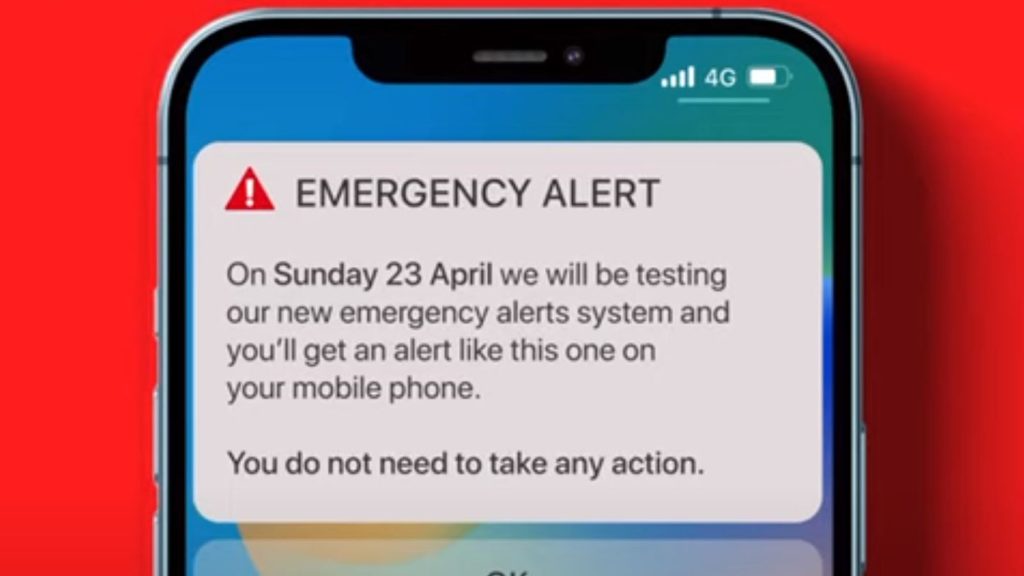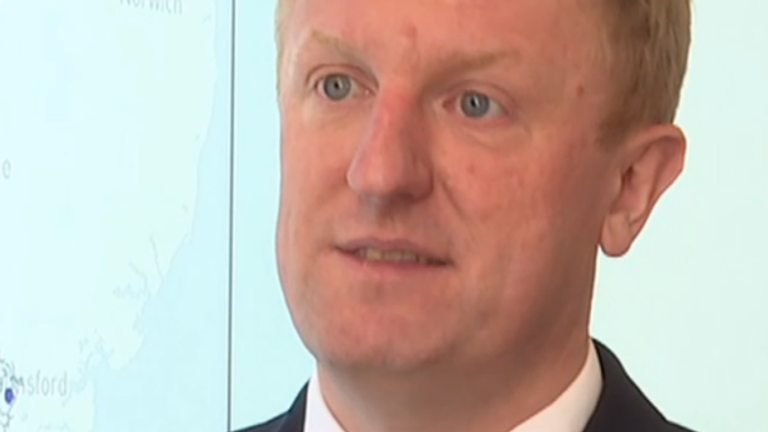Emergency alert test happens today – here’s everything you need to know | Science & Tech News

Tens of millions of phones will receive an emergency alert today as the government tests the system nationwide for the first time.
At 3pm, a distinct sound and vibration will be accompanied by a message telling people a new service has launched that will “warn you if there’s a life-threatening emergency nearby”.
It will last about 10 seconds, and Deputy Prime Minister Oliver Dowden has assured people they can simply “swipe away” the notification.
“Keep calm and carry on – that is the British way, and it is exactly what the country will do when they receive this test alert at 3pm today,” he said.
WHAT THE TEST MESSAGE WILL SAY
“This is a test of Emergency Alerts, a new UK government service that will warn you if there’s a life-threatening emergency nearby.
“In a real emergency, follow the instructions in the alert to keep yourself and others safe. Visit gov.uk/alerts for more information.
“This is a test. You do not need to take any action.”
Ministers hope it will get the public used to what the alerts look and sound like, in case they need to be sent out in future during crises such as extreme weather, flooding, and fires.
Mr Dowden said “it really is the sound that could save your life”.
But critics have said the alerts themselves could put people’s safety at risk, including drivers who may become distracted and domestic violence victims who keep a secret phone.
Meanwhile, sports stadiums, theatres, and cinemas are among those planning how to guard against disruption to large events when Sunday’s test goes off.
The emergency alert will appear like this
The company behind the UK’s alert system has worked on the same technology for other governments, and has insisted it will be a “game changer” for public safety.
Everbridge has already deployed it in the likes of Germany, Spain, New Zealand, and Singapore.
Valerie Risk, vice president of public safety systems, told Sky News: “We’ve had church bells, fires, smoke signals; humans have been alerting populations for centuries in many ways and this is the next generation.”
How does the technology work?
The emergency alerts are broadcast via mobile phone masts and work on all 4G and 5G phone networks.
That’s different to how the government sent out lockdown orders during the pandemic, when SMS messages were sent directly to phone numbers.
It means whoever sends an alert does not need your number, so it’s not something you need to reply to, nor will you receive a voicemail if you miss it. No location or other data will be collected, either.
It also means alerts could be sent to tablets and smartwatches on their own data plans.
Anyone in the range of a mast will receive an alert, and they can be tuned based on geography – for example, Manchester residents would not need an alert about life-threatening flooding in Cornwall.
Manuel Cornelisse, Everbridge’s senior director for public warnings, told Sky News the tech had proved its worth in other countries, including his homeland of the Netherlands.
“It’s a very well proven technology with very strong, quality reach,” he said.
“And because it’s part of the very highest priority of signalling, the service will always remain available, even if a network gets congested when there is massive usage (such as at a sports ground).”
Read more:
How emergency alerts work in other countries
Please use Chrome browser for a more accessible video player

0:48
Could it go wrong?
There have been instances of emergency alerts not going to plan.
In 2020, an emergency alert warning millions of people of an “incident” at a nuclear power plant near Toronto in Canada was pushed out in error.
Two years prior, Hawaiian authorities accidentally warned people of an incoming ballistic missile strike.
And Florida residents had a rude awakening this week, when a test alert mistakenly blared out at 4.45am.
The state has contracted Everbridge for its emergency alert system since 2016, and Governor Ron DeSantis has demanded “swift accountability” for the mistake.
Lorenzo Marchetti, the firm’s public affairs manager, said Florida’s system uses different tech than the UK’s, but acknowledged it is not immune to human error.
“We are investigating, it appears to be an unfortunate procedural error in the dispatching of the message,” he said.
“Sometimes these kinds of things might be out of the control of the technology itself.”
Ms Risk said the sending of messages is “very closely managed and regulated”, and mistakes were “very rare”.
Sending alerts requires high-level security access, and there is a confirmation prompt before any are sent.
‘Please don’t turn it off’
Incidents like those in Florida may give sceptics more reason to want to switch the alerts off.
Mr Dowden has urged people not to ahead of Sunday afternoon’s test, which will be sent from a national situation centre inside the Cabinet Office.
Roger Hargreaves, director of the government’s emergency COBRA committee, warned switching it off would be like taking batteries out of your smoke alarm.
He added: “The message that people get through this system is one that contains information that is useful to them, helps protect life and limb, sets out specific action we would like them to take.”
HOW TO TURN THE ALERT OFF
Despite the government’s pleas, domestic violence charities are concerned the alert could give away secret phones people experiencing abuse are keeping hidden.
If you’re concerned, it’s easy to switch them off.
On iOS and Android devices, search settings for “emergency alerts” and turn off “severe alerts” and “emergency alerts”.
On Huawei devices running EMUI 11 or older, search settings for “emergency alerts” and turn off “extreme threats”, “severe threats”, and “show amber alerts”.
The other option is switching off the device entirely or putting it in aeroplane mode before 3pm.
Will alerts be used often?
Ministers have insisted alerts will only be sent in “life-threatening” situations.
But those behind the system have seen increased adoption by governments in recent years, with the pandemic and climate-related emergencies increasing the need for fast and direct communication with the public.
The EU has introduced a directive requiring member states to have a phone-based public warning system.
Ms Risk said the tech will keep improving, with satellite the potential next frontier after being rolled out on some smartphones to help people get emergency help without any mobile masts nearby.







Recent Comments